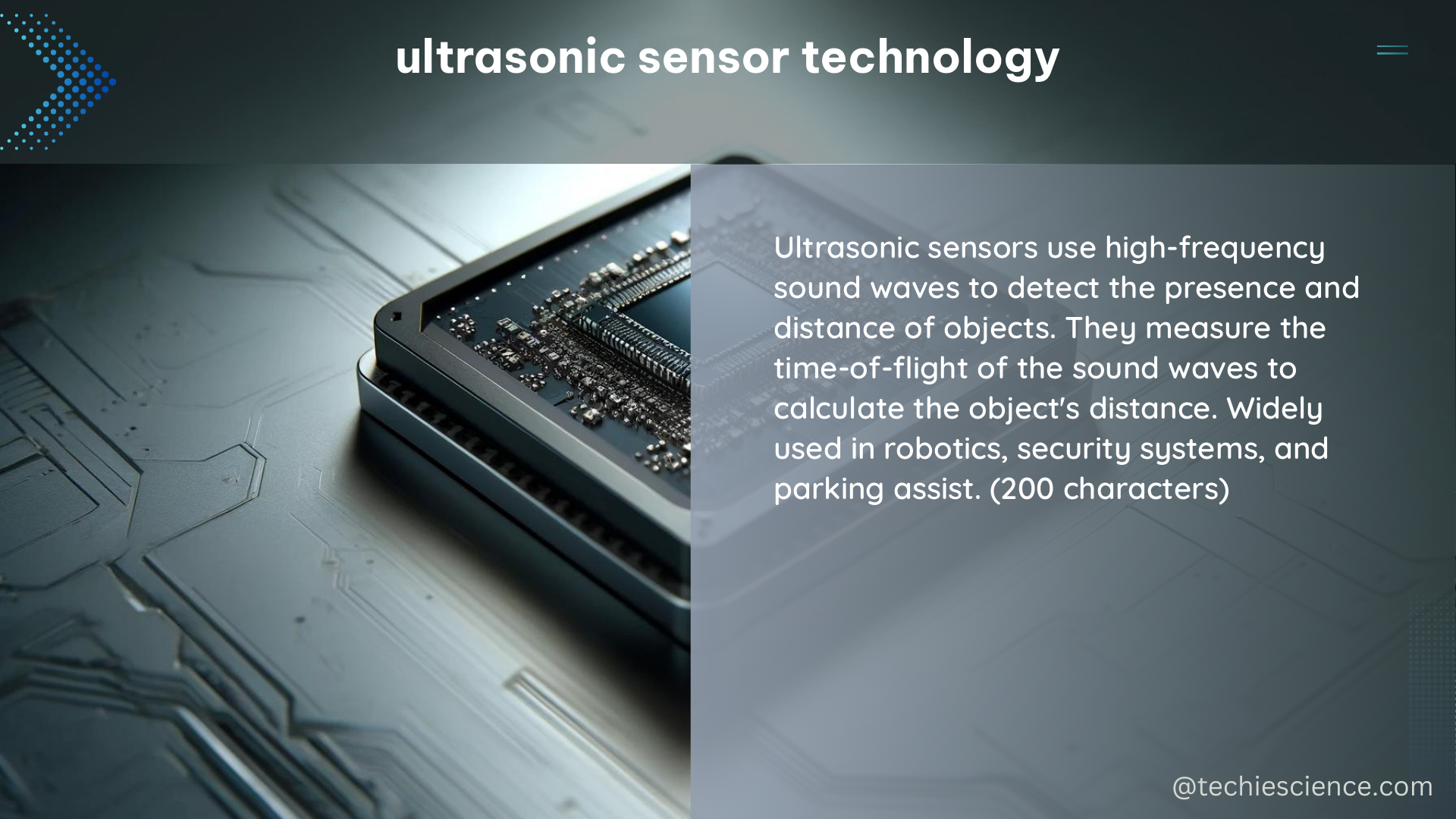Ultrasonic sensor technology is a non-contact method of measuring distance that uses sound waves. The sensor emits a high-frequency sound wave, typically above the range of human hearing, and measures the time it takes for the wave to bounce back after hitting an object. By knowing the speed of sound, the distance to the object can be calculated using the time-of-flight principle.
Understanding the Basics of Ultrasonic Sensors
Ultrasonic sensors operate on the principle of sound wave propagation. They consist of a transmitter, which generates the ultrasonic wave, and a receiver, which detects the reflected wave. The time between the transmission and reception of the wave is measured and converted into distance using the formula:
Distance = (Time × Speed of Sound) / 2
The speed of sound in air at 20°C is approximately 343 m/s or 1,125 ft/s. This value can be adjusted based on the temperature and humidity of the environment to improve the accuracy of the distance measurement.
Popular Ultrasonic Sensor: HC-SR04
One of the most popular ultrasonic sensors is the HC-SR04, which operates at a frequency of 40kHz. It has a measurable range of 2cm to 400cm with an accuracy of 3mm. The HC-SR04 sensor consists of a transmitting piezoelectric crystal and a receiving piezoelectric crystal.
| Specification | Value |
|---|---|
| Operating Voltage | 5V DC |
| Operating Current | 15mA |
| Ultrasonic Frequency | 40kHz |
| Measuring Range | 2cm to 400cm |
| Accuracy | ±3mm |
| Trigger Input Signal | 10μs TTL pulse |
| Echo Output Signal | Input TTL level signal and the range in proportion |
| Dimension | 45mm x 20mm x 15mm |
The HC-SR04 sensor is widely used in various applications, such as robotics, proximity sensing, and advanced driver-assistance systems (ADAS), due to its reliability, accuracy, and cost-effectiveness.
Advantages of Ultrasonic Sensors

Ultrasonic sensors offer several advantages over other sensing technologies:
-
Non-Contact Measurement: Ultrasonic sensors can measure the distance to an object without physically touching it, making them suitable for applications where direct contact is not possible or desirable.
-
Reliability in Varying Environments: Ultrasonic sensors are reliable in any lighting environment, including complete darkness, and can be used both indoors and outdoors.
-
Collision Avoidance: Ultrasonic sensors can be used for collision avoidance in robotics and autonomous vehicles, as they can detect obstacles and provide feedback for navigation.
-
Versatility: Ultrasonic sensors can measure the distance to a wide range of materials, including metal, plastic, glass, wood, rocks, sand, oil, and water, making them suitable for a variety of applications.
-
Cost-Effectiveness: Ultrasonic sensors are generally more cost-effective compared to other distance measurement technologies, such as laser-based sensors.
Challenges and Considerations
When using multiple ultrasonic sensors, it is important to consider the potential for crosstalk or interference between the sensors. This can be mitigated by connecting the sensors in a way that prevents disruption of the ultrasonic signals, such as using different trigger frequencies or time-division multiplexing.
Additionally, the accuracy of ultrasonic sensors can be affected by factors such as temperature, humidity, and the surface properties of the target object. Proper calibration and environmental compensation may be necessary to ensure accurate distance measurements.
Advanced Applications of Ultrasonic Sensor Technology
Beyond distance measurement, ultrasonic sensor technology has a wide range of advanced applications:
-
Object Detection and Collision Avoidance: By using multiple ultrasonic sensors, it is possible to create a 3D representation of the environment, enabling robots and autonomous vehicles to navigate safely and efficiently. Ultrasonic sensors can be combined with other sensing technologies, such as infrared and LiDAR, to provide redundancy and improve accuracy.
-
Underwater Exploration: Ultrasonic sensors can be used to measure the distance between a submersible and the seafloor, enabling accurate mapping of the ocean floor. They can also be used to detect and track marine life, providing valuable data for conservation efforts.
-
Medical Imaging: Ultrasonic waves can be used to create images of internal organs and tissues, providing a non-invasive and cost-effective alternative to other imaging techniques, such as CT and MRI scans.
-
Industrial Applications: Ultrasonic sensors are widely used in industrial applications, such as level sensing in grain bins, water level monitoring, and proximity detection in manufacturing processes.
-
Automotive Applications: Ultrasonic sensors are a key component of advanced driver-assistance systems (ADAS), enabling features like parking assistance, blind spot detection, and collision avoidance.
Conclusion
Ultrasonic sensor technology is a versatile and reliable method of measuring distance and detecting objects. The HC-SR04 is a popular ultrasonic sensor that offers a range of 2cm to 400cm with an accuracy of 3mm, making it suitable for a wide range of applications. By understanding the principles of ultrasonic sensing and the various challenges and considerations, you can effectively integrate this technology into your projects and applications.
References
- Ultrasonic Sensing Basics (Rev. D) – Texas Instruments: https://www.ti.com/lit/an/slaa907d/slaa907d.pdf?ts=1704718136760
- How Ultrasonic Sensors Work – MaxBotix: https://maxbotix.com/blogs/blog/how-ultrasonic-sensors-work
- Distance Measurement Using Ultrasonic Sensor and Arduino – GeeksforGeeks: https://www.geeksforgeeks.org/distance-measurement-using-ultrasonic-sensor-and-arduino/

The lambdageeks.com Core SME Team is a group of experienced subject matter experts from diverse scientific and technical fields including Physics, Chemistry, Technology,Electronics & Electrical Engineering, Automotive, Mechanical Engineering. Our team collaborates to create high-quality, well-researched articles on a wide range of science and technology topics for the lambdageeks.com website.
All Our Senior SME are having more than 7 Years of experience in the respective fields . They are either Working Industry Professionals or assocaited With different Universities. Refer Our Authors Page to get to know About our Core SMEs.